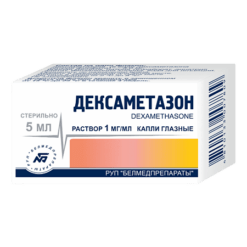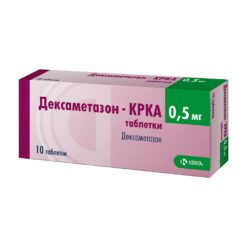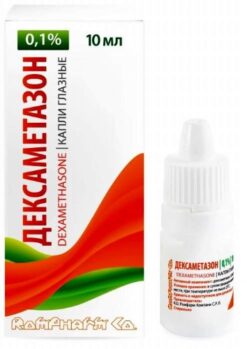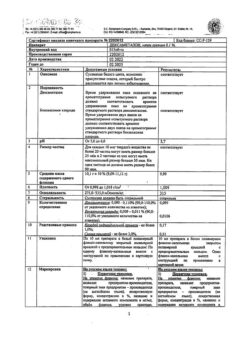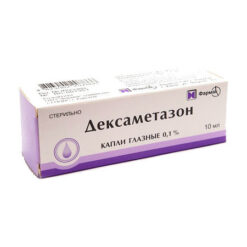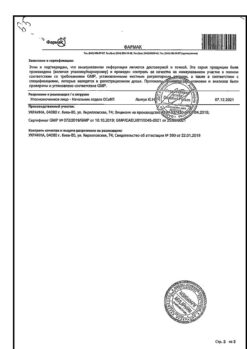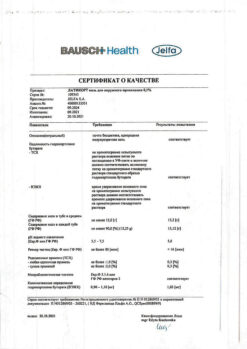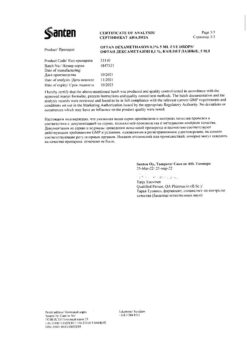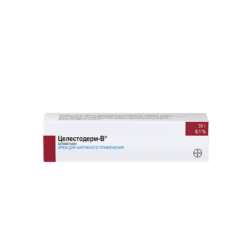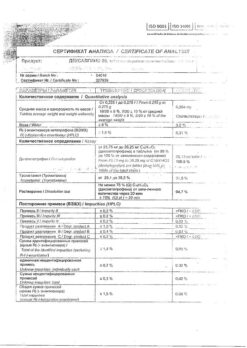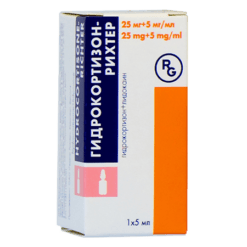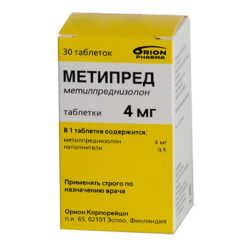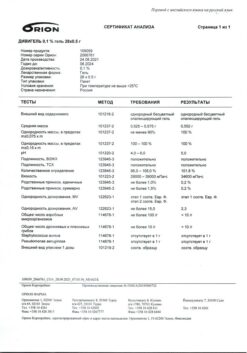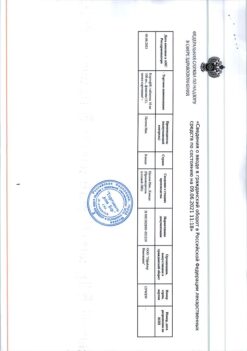Subtotal: €6.01
Dexamethasone, 4 mg/ml 1 ml 10 pcs
€3.37 €3.00
Pharmacological action
Pharmacodynamics
It interacts with specific cytoplasmic receptors and forms a complex penetrating into the cell nucleus and stimulating mRNA synthesis: the latter induces formation of proteins, including lipocortin, mediating cellular effects. Lipocortin inhibits phospholipase A2, suppresses arachidonic acid liberation and inhibits the biosynthesis of endoperoxides, PG, leukotrienes, contributing to the processes of inflammation, allergy, etc.
Inhibits the release of inflammatory mediators from eosinophils and mast cells. Inhibits the activity of hyaluronidase, collagenase and proteases, normalizes the functions of the intercellular matrix of cartilage and bone tissue. It decreases capillary permeability, stabilizes cell membranes, including lysosomal membranes, inhibits release of cytokines (interleukins and gamma interferon) from lymphocytes and macrophages, causes involution of lymphoid tissue. Restores sensitivity of adrenoreceptors to catecholamines. Accelerates protein catabolism, decreases glucose utilization by peripheral tissues and increases gluconeogenesis in the liver. Reduces absorption and increases calcium excretion; inhibits sodium (and water) ACTH secretion.
Pharmacokinetics
In intravenous administration binds to specific carrier protein – transcortin – by 70-80%; in high doses of the drug binding to proteins is reduced to 60-70% due to transcortin saturation. Passes easily through histohematic barriers, including the blood-brain and placental ones. When ingested, it is rapidly and completely absorbed mainly in the proximal small intestine; absorption in the distal part is approximately half that in the proximal part. The absorption is reached within 1-2 hours. It is biotransformed in the liver, mainly by conjugation with glucuronic and sulfuric acids, to inactive metabolites.
The blood elimination half-life of T1/2 is 3-5 hours, the biological half-life is 36-54 hours. During parenteral administration it is metabolized faster and, correspondingly, pharmacological effects are shorter. It is excreted mainly with urine (a small part is excreted by lactating glands) as 17-ketosteroids, glucuroids and sulfates. About 15% of dexamethasone is excreted unchanged in the urine. When applied to the skin absorption is determined by many factors (skin integrity, presence of occlusive dressing, dosage form, etc.) and varies greatly.
Indications
Addison’s disease, congenital adrenal hypoplasia, adrenal insufficiency (usually in combination with mineralocorticoids), adrenogenital syndrome, thyroiditis (acute, subacute), hypothyroidism, tumor hypercalcemia, shock (anaphylactic, post-traumatic, postoperative, cardiogenic, blood transfusion, etc.), rheumatoid arthritis in the acute phase, acute rheumatic carditis, collagenosis (rheumatic diseases, disseminated lupus erythematosus, etc.), inflammatory and degenerative diseases of the joints (arthritis, tendovaginitis, bursitis, epicondylitis, styloiditis, osteochondrosis, osteoarthritis, ankylosing spondylitis, etc.), myositis, infectious-allergic bronchial asthma, status asthmaticus, anaphylactoid reactions, in incl. caused by drugs;
cerebral edema (with tumors, traumatic brain injury, neurosurgical intervention, cerebral hemorrhage, encephalitis, meningitis, radiation damage to the lungs);
nonspecific ulcerative colitis, hepatitis, sarcoidosis, berylliosis, disseminated tuberculosis (only in combination with anti-tuberculosis drugs), Loeffler’s disease and other severe respiratory diseases;
anemia (autoimmune, hemolytic, congenital, hypoplastic, idiopathic, erythroblastopenia), idiopathic thrombocytopenic purpura (in adults), secondary thrombocytopenia, lymphoma (Hodgkin and non-Hodgkin), leukemia, lymphocytic leukemia (acute, chronic), agranulocytosis, plasmacytoma and other blood diseases;
nephrotic syndrome; severe infectious diseases (with mandatory combination with antibiotics), severe inflammatory processes after eye injuries and operations.
Pharmacological effect
Pharmacological action
Pharmacodynamics
It interacts with specific cytoplasmic receptors and forms a complex that penetrates the cell nucleus and stimulates the synthesis of mRNA: the latter induces the formation of proteins, including lipocortin, that mediate cellular effects. Lipocortin inhibits phospholipase A2, suppresses the liberation of arachidonic acid and inhibits the biosynthesis of endoperoxides, PGs, leukotrienes, which contribute to inflammation, allergies, etc.
Prevents the release of inflammatory mediators from eosinophils and mast cells. Inhibits the activity of hyaluronidase, collagenase and proteases, normalizes the functions of the intercellular matrix of cartilage tissue and bone tissue. Reduces capillary permeability, stabilizes cell membranes, incl. lysosomal, inhibits the release of cytokines (interleukins and gamma-interferron) from lymphocytes and macrophages, causes involution of lymphoid tissue. Restores the sensitivity of adrenergic receptors to catecholamines. Accelerates protein catabolism, reduces glucose utilization by peripheral tissues and increases gluconeogenesis in the liver. Reduces absorption and increases excretion of calcium; inhibits sodium (and water) ACTH secretion.
Pharmacokinetics
When administered intravenously, it binds to a specific carrier protein – transcortin – by 70-80%; when high doses of the drug are administered, protein binding is reduced to 60-70% due to saturation of transcortin. Easily passes through histohematic barriers, including blood-brain and placental. When taken orally, it is quickly and completely absorbed mainly in the proximal small intestine; absorption in the distal region is approximately half that in the proximal region. Reach is achieved within 1-2 hours. Biotransformed in the liver, mainly by conjugation with glucuronic and sulfuric acids, to inactive metabolites.
The half-life of T1/2 from the blood is 3-5 hours, the biological half-life is 36-54 hours. When administered parenterally, it is metabolized faster and, accordingly, the pharmacological effects are less durable. It is excreted mainly in the urine (a small part by the lactating glands) in the form of 17-ketosteroids, glucuroids, and sulfates. About 15% of dexamethasone is excreted unchanged in the urine. When applied to the skin, absorption is determined by many factors (integrity of the skin, presence of an occlusive dressing, dosage form, etc.) and varies greatly.
Special instructions
Restricted for use in: peptic ulcers of the gastrointestinal tract, peptic ulcer of the stomach and duodenum, esophagitis, gastritis, intestinal anastomosis (in the immediate history); congestive heart failure, arterial hypertension, thrombosis, diabetes mellitus, osteoporosis, Itsenko-Cushing’s disease, acute renal and/or liver failure, psychosis, convulsive states, myasthenia gravis, open-angle glaucoma, AIDS, pregnancy, breastfeeding.
Active ingredient
Dexamethasone
Composition
Active substance:
dexamethasone sodium phosphate (in terms of dexamethasone phosphate) – 4.0 mg per 1 ml.
Pregnancy
Use during pregnancy is allowed if the expected effect of therapy outweighs the potential risk to the fetus. Breastfeeding should be stopped during treatment.
Contraindications
Hypersensitivity, systemic mycoses, amoebic infections, infectious lesions of joints and periarticular soft tissues, active forms of tuberculosis, the period before and after preventive vaccinations (especially antiviral ones), glaucoma, acute purulent eye infection (retrobulbar administration).
Side Effects
Sodium and water retention, loss of potassium and calcium, edema, erosive and ulcerative lesions of the gastrointestinal tract (with exacerbation of peptic ulcer disease up to perforation, bleeding), hemorrhagic pancreatitis, gastrointestinal atony, increased appetite, nausea and vomiting, hepatomegaly, muscle weakness, myopathy, osteoporosis, pathological fractures, tendon ruptures, arrhythmia, bradycardia, increased blood pressure, congestive heart failure, myocardial infarction and dystrophy, Itsenko-Cushing syndrome, hyperglycemia, hyperlipoproteinemia, negative nitrogen balance, dysmenorrhea, growth retardation in children, hirsutism, decreased immunity, suppression of regenerative and reparative processes, dizziness, headaches, mood disorders, psychoses, increased intracranial pressure, convulsions, thinning and vulnerability of the skin, petechiae, ecchymoses, stretch marks, erythema and changes in skin pigmentation, increased sweating, increased intraocular pressure, exophthalmos;
thrombosis and thromboembolism, withdrawal syndrome (malaise, pain: headaches, abdominal, joint and muscle);
depression, secondary adrenal insufficiency;
rarely – allergic reactions (rash, itching).
Interaction
The therapeutic and toxic effects of dexamethasone are reduced by barbiturates, phenytoin, rifampicin (accelerate metabolism); somatotropin; antacids (reduce absorption), enhance – estrogen-containing oral contraceptives.
The risk of arrhythmias and hypokalemia is increased by cardiac glycosides and diuretics, the likelihood of edema and arterial hypertension is increased by sodium-containing drugs and nutritional supplements, severe hypokalemia, heart failure and osteoporosis is increased by amphotericin B and carbonic anhydrase inhibitors; risk of erosive and ulcerative lesions and bleeding from the gastrointestinal tract – non-steroidal anti-inflammatory drugs.
When used simultaneously with live antiviral vaccines and against the background of other types of immunization, it increases the risk of viral activation and the development of infection.
Weakens the hypoglycemic activity of insulin and oral antidiabetic agents; anticoagulant – coumarins; diuretic – diuretic diuretics; immunotropic – vaccination (suppresses antibody formation).
Worsens the tolerance of cardiac glycosides (causes potassium deficiency), reduces the concentration of salicylates and praziquantel in the blood.
Overdose
Reports of acute toxic poisoning and/or death due to glucocorticoid overdose are extremely rare.
If adverse events develop, treatment is symptomatic, aimed at maintaining vital functions; Itsenko-Cushing syndrome – administration of aminoglutemide.
Manufacturer
Belmedpreparaty, Belarus
| Manufacturer | Belmedpreparaty, Belarus |
|---|---|
| Medication form | solution for injection |
| Brand | Belmedpreparaty |
Other forms…
Related products
Corticosteroid hormones
Buy Dexamethasone, 4 mg/ml 1 ml 10 pcs with delivery to USA, UK, Europe and over 120 other countries.




